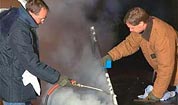|

|
|
 |
|
 |
|
The Icing Research Tunnel (IRT) is NASA Glenn's busiest facility. Built at the end of World War II, the IRT was instrumental in developing and testing ice protection systems for piston- and propeller-driven aircraft. Since that time, the IRT has been updated with a larger fan motor, more efficient heat exchanger and turning vanes, improved fan blades, computerized tunnel controls, and electronic data acquisition, storage, and processing.
The IRT has played a substantial role in developing, testing, and certifying methods to prevent ice buildup on gas turbine powered aircraft. Work continues today in the investigation of deicing and anti-icing fluids for use on the ground, deicing and anti-icing research on aircraft including rotor systems and certification of ice protection systems for military and commercial aircraft.
The IRT can produce continuous airspeeds from 50 to 350 knots and
temperatures as low as -25°F year-round, controllable to within
one degree Fahrenheit. Supercooled water droplets between 15 and
50 microns with water content controllable between 0.2 and 2.5g/m3
can be produced to form an icing cloud. The 6 ft. high, 9 ft. wide,
20 ft long test section can accommodate many full-sized aircraft
components as well as large-scale models and an 8.6 ft diameter turntable in the test section can rotate horizontally +/-20 degrees for various angles of attack for various angles of attack. |
|
 |
|
+ Read more about our capabilities... |
|
 |
|



